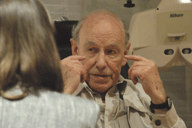We continue our weekly look at the GOC core competencies by expanding our argument over the significance of good comminication skills for accurate history and symptoms taking
For the purposes of guiding pre-registration optometrists through their year in practice, the GOC suggests a list of competencies within each core subject which need to be achieved as the year progresses (the first quarter requirements were outlined in this series - optician July 1, 2005). In order to demonstrate the ability to take an accurate history from a variety of patients with a range of optometric conditions, it is perhaps useful to think of some specific examples. When assessing binocular vision related symptoms, it is essential to be precise as to the exact nature of the presenting symptoms. Here are a few useful questions to consider when someone is complaining of double vision.
Do you see two separate images, or is it just blurry or shadowy?
Much of the double vision reported by patients is simply blur, particularly the shadowing caused by uncorrected astigmatism.
Is it still double if you cover one eye up?
Monocular diplopia may be caused by corneal, lens or retinal disease, uncorrected astigmatism, poorly centred contact lenses, bifocal segments and by perceptual anomalies associated with brain tumours, vascular disorders and migraine.
Are things double when you are looking straight at them, or is it only when you are looking at something else?
Physiological diplopia is a normal consequence of having two eyes and is usually not noticed. Sometimes circumstances will bring it to the attention of the patient and when the patient checks whether it is still there, it is. Children seem to be particularly adept a discovering physiological diplopia, or at least less inhibited at reporting it.
Is it double this way or that way? (With appropriate gestures)
Purely horizontal diplopia could be caused by the breakdown of concomitant heterophoria, or more rarely by a horizontal rectus palsy. Any vertical element suggests paresis, involving the vertical recti or obliques. When was the first time you experienced this?
When was the first time you experienced this?
Sudden and recent onset implies catastrophic change, such as that caused by acquired muscle palsy. Long-standing diplopia may suggest a more static condition, such as heterophoria that breaks down or a mechanical incomitancy. In these latter cases, onset may be only vaguely recalled, if at all.
Is it always double, or only sometimes?
Constant diplopia suggests a relatively constant angle between the eyes. Single muscle palsies rarely cause diplopia in the primary position, although those involving horizontal recti may do so. Intermittent diplopia may depend on the position or fixation distance of the target, or on fusional reserves which are coping only part of the time.
Is it double only when you look in a particular direction?
An affirmative answer would be a strong indication of recently acquired muscle palsy. The obvious follow-up question is 'which direction do you see double?'
Is the double vision worse when you look close up, or in the distance?
The deviation may vary with fixation distance, implying an abnormal AC/A ratio, or with elevation and depression of the eyes, since most subjects depress the eyes to read. Where the deviation is worst at distance, a marked 'V' pattern is a common finding. Where a vertical element is present, if the vertical imbalance is greater at distance than near, a vertical rectus is implicated. If greater at near an oblique is suggested. Obliques have their greatest vertical action during convergence. Recti are more effective vertically when the visual axes are parallel.
Is it happening more or less often?
Increased frequency may be due to a deteriorating fusional reserve or to an increasing deviation.
Can you make it single again?
Generally an affirmative answer would indicate a heterophoric patient that is breaking down. Acquired muscle palsy tends to have a more catastrophic onset, but there are exceptions.
Have you been bumping in to things, or knocking things over?
Clumsiness may arise from the spatial disturbance that accompanies muscle palsy in the field of action of the palsied muscle. Some patients who have not noticed diplopia offer this as a presenting symptom.
Have you had any bangs on the head?
Head trauma is a common cause of acquired muscle palsy, as is neurological disorder. Careful questioning regarding general health would feature in any eye examination.
OPTICIAN would like to thank Andrew Franklin for his assistance with this article
